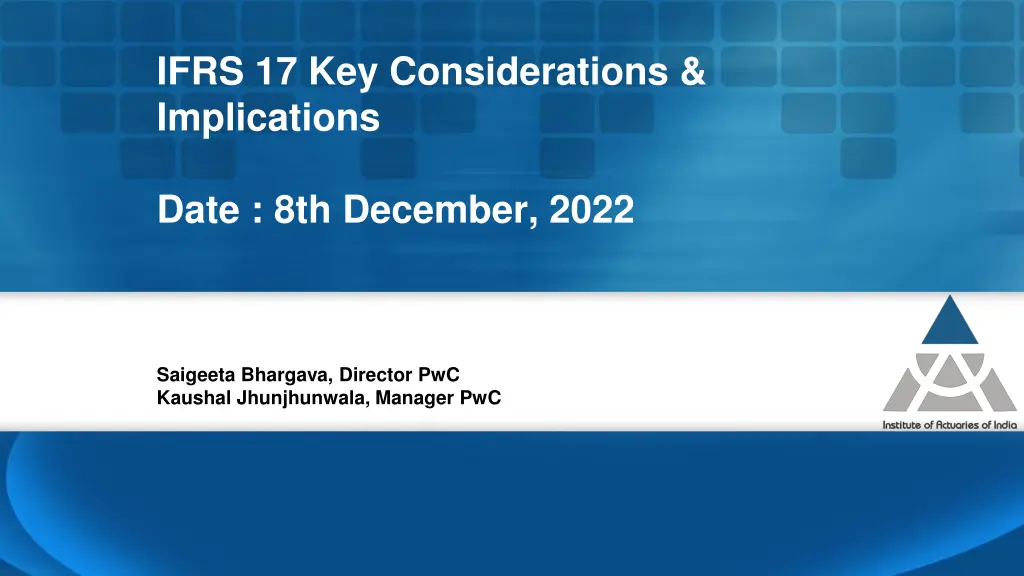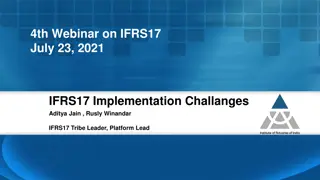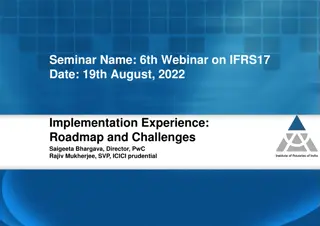
Key Considerations and Implications of IFRS 17 for Insurance Contracts
Explore the key technical, post-implementation, and other considerations of IFRS 17, including measurement models, contractual service margin, data availability, post-implementation challenges, and more. Stay informed about important factors affecting insurance contracts under IFRS 17.
Download Presentation

Please find below an Image/Link to download the presentation.
The content on the website is provided AS IS for your information and personal use only. It may not be sold, licensed, or shared on other websites without obtaining consent from the author. If you encounter any issues during the download, it is possible that the publisher has removed the file from their server.
You are allowed to download the files provided on this website for personal or commercial use, subject to the condition that they are used lawfully. All files are the property of their respective owners.
The content on the website is provided AS IS for your information and personal use only. It may not be sold, licensed, or shared on other websites without obtaining consent from the author.
E N D
Presentation Transcript
IFRS 17 Key Considerations & Implications Date : 8th December, 2022 Saigeeta Bhargava, Director PwC Kaushal Jhunjhunwala, Manager PwC
Contents 1. Key Technical Considerations 2. Other Considerations 3. Post Implementation Considerations 4. Investor Communication www.actuariesindia.org
Key Technical Considerations GMM Option to present changes in financial risk to other comprehensive income (OCI) Determination of investment-return services and coverage units Measuring options and guarantees This illustration highlights certain key and new accounting judgements and estimates that a Company need to make to measure its insurance contract liabilities balance and its insurance revenue and insurance service expenses under IFRS 17. ! ! ! Separation and combination of components Contract boundary determination Measurement model determination Unit of account determination Scope VFA Cash flows within the boundary (including directly attributable expenses) Determining the period of the cash flows projection General measurement model (GMM) Variable Fee Approach (VFA) Premium Allocation Approach (PAA) VFA eligibility Mutualisation of cash flows Measuring options and guarantees Definition of insurance contracts Significant insurance risk transfer Insurance components Embedded derivatives/ Investment components Other goods and services Definition of Portfolios and Groups Profitable vs onerous contracts Time-band cohorts ! PAA PAA eligibility Initial recognition ! Contractual Service Margin ( CSM ) Movements in these components are presented mainly as: Insurance revenue Insurance service expense OCI Changes related to future services adjusting CSM Best Estimated Liability ( BEL ) Risk adjustment ( RA ) ! Assumptions Discount Rate Coverage Unit Best estimate Expense Contract modifications ! Subsequent measurement RA CSM BEL Legends Contract definitions and group Income statement and Presentation Measurement assumptions OBS ! Recognition and measurement of contracts Contract boundary and measurement models Transition measurement approaches Methodology choices High Judgement ! PwC | IFRS 17 APAC Conference November 2022 3
Other Considerations Data Availability, Quality Infrastructure volume of data, CSM engine CSM engine choice Resource Cloud vs on prem Complex Process Project Governance Investor Communication Evolving Regulatory Landscape Dual Reporting www.actuariesindia.org
Post Implementation Considerations Work through remediation lists - tactical to strategic Remediation Extremely long close cycle - Improve close cycles Technology issues (e.g. upgrades, unstable data model, etc) Concerns about releasing numbers Policy recalibration, Reconciliation with SII, EV Recalibration Key accounting choices or future cash flows need to be revisited after first run Adapting the solutions to consider revised policy choices People capacity, capability, fluency with IFRS 17 Resources Data - quality, new attributes, reconciliation, BAU vs ongoing project demand : IT, Accounting, Actuarial www.actuariesindia.org
Post Implementation Consideration KPIs Existing KPIs that will be impacted Existing KPIs that may be unaffected Cash / dividend / free surplus metrics: Similar level of focus to today. Solvency-based (e.g. ratio) metrics: Similar level of focus to today also. May be second order IFRS 17 impacts. Potential new KPIs & disclosures New business CSM: Comparison to VNB metrics Profit Margin: Margin-based analysis of results likely to be retained (with different explanatory items). Insurance result against insurance revenue CSM analysis of movements and maturity analyses: To demonstrate the expected release of future CSM into profits Earnings per share (EPS) & Return on equity (ROE): Expected to remain key, but may be rebased or further adjusted given impact from transition to IFRS 17 (e.g. CSM) Insurance contract revenue: How will this be used versus GWP or PVNBP today (if at all)? Value Metric: Moody s and Fitch have come up with a proposal to use IFRS equity + Factor1 * CSM + Factor2 * RA www.actuariesindia.org
Investor Communication Background Requirements under IAS 8 No disclosure specifications outlined. Most companies have explained expected implications. Some companies have quantified the implications. Most of these Companies currently under SII regime We have outlined the results from these in the next few slides www.actuariesindia.org
Key Decisions under IFRS 17 Discount Rates Risk Adjustment P&L vs OCI 63% of insurers adopted a Value at Risk approach 86% of insurers adopted a OCI approach 78% of insurers adopted a Bottom-Up approach P&L OCI VaR PAD CoC Bottom Up Top Down One of the companies indicated that their risk adjustment is based on 62.5th 67.5th percentile www.actuariesindia.org
Impact of IFRS 17 on key KPIs: Change in BEL Reduction in Shareholder Equity Comprehensive Shareholder Capital includes Net CSM which has remained unchanged for most companies 90% of insurers expect very minor changes in IFRS 17 BEL as compared to SII BEL 67% of insurers expect a significant fall in the shareholder equity Minor Changes Major Changes No Change 0% to 10% <20% Transition primarily FV or MRA except for last 5 years that some companies indicated to have used FRA www.actuariesindia.org
Investor Communication Key take-aways A few companies indicated that the cash flows and underlying capital generation of their businesses are unaffected by IFRS 17, and the standard will have no impact on their Solvency II performance metrics. Companies have indicated that revenue will get depressed initially and then stabilize in the future Companies are not expecting their business strategies to change under the standard. www.actuariesindia.org


